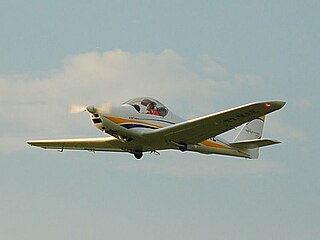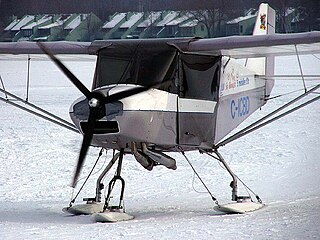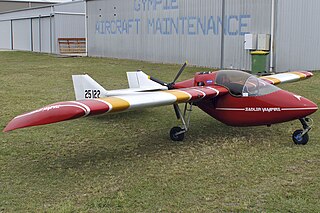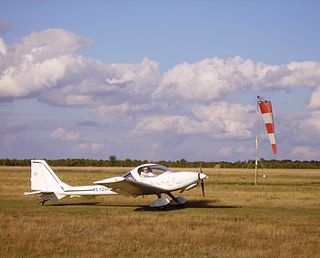Jabiru Aircraft Pty Ltd is an Australian aircraft manufacturer that produces a range of kit- and ready-built civil light aircraft in Bundaberg, Queensland. The company also designs and manufactures a range of light aircraft engines. Types past and present include microlights, including the Calypso, two-seat trainers and recreational aircraft and four-seat aircraft (J400/J430/J450).

The Kappa 77 KP-2U Sova, later produced as the Jihlavan KP-2U Skyleader and most recently as the Jihlavan Skyleader, is a two-seat civil utility aircraft designed in the Czech Republic and available in kit form for home building. It is a conventional low-wing monoplane featuring all-metal construction and tricycle undercarriage.

The Best Off Skyranger is a French-designed two-seat ultralight utility aircraft, produced by Best Off, of Toulouse. It is a high-wing conventional monoplane with tricycle undercarriage, and of fabric-covered tubular construction.

The CSA SportCruiser is a two-seat, single engine, tricycle undercarriage, fixed-wing aircraft that was introduced in 2006 by Czech Aircraft Works (CZAW), now named Czech Sport Aircraft.

The Sadler SV-1 Vampire is a single-seat ultralight sport aircraft developed in the United States in the early 1980s. It is uncharacteristic of ultralight designs in both its layout and its construction. The Vampire is a mid-wing cantilever monoplane of pod-and-boom configuration and twin booms joined by a common horizontal stabilizer. The wings fold for storage and transport, and the undercarriage is of fixed tricycle type. The single engine and pusher propeller are mounted at the rear of the pod that also includes the open cockpit. Construction throughout is of metal.

The Remos G3 Mirage and Remos GX are German high wing, two seat, single engine light aircraft, built by Remos AG of Pasewalk. The aircraft is supplied as a kit for amateur construction or complete and ready-to-fly.

The Supermarine Aircraft Spitfire is an American homebuilt aircraft produced in kit form by Supermarine Aircraft. A replica of the famous British Supermarine Spitfire World War II fighter, it was originally produced to 75% scale. Subsequent models have increased the scale of the fuselage and added a second seat.

The InterPlane Skyboy is a two-seat, side-by-side, high wing, single engine, pusher configuration ultralight aircraft that was manufactured as a completed aircraft by InterPlane Aircraft of Zbraslavice, Czech Republic.

The B&F Fk9, also marketed as the FK-Lightplanes FK9, is a German-designed single-engine, two-seat ultralight, first flown in 1989. It has been developed from a mixed structure, fabric covered aircraft to a wholly composite machine. It remains in production at factories in Germany and Poland and has sold in large numbers, flying on four continents.

The Breezer is a low-wing, single-engine ultralight aircraft, seating two side by side. Designed and built in Germany, it meets both European and US light-sport aircraft requirements and has been in production since 2001.

The Titan Tornado is large family of cantilever high-wing, pusher configuration, tricycle gear-equipped kit aircraft manufactured by Titan Aircraft of Austinburg, Ohio, for amateur construction.

The Raj Hamsa X-Air is an Indian, two-seat, high-wing, tricycle gear, tractor configuration, ultralight aircraft produced by Raj Hamsa Ultralights of Bangalore, Karnataka in kit form, for amateur construction.

The Roko Aero NG4 is a single-engined sport aircraft, available in both light-sport aircraft and ultralight models, which seats two side by side. It is in production in the Czech Republic.
The Brumby Aircraft Brumby 600, also known as the Brumby LSA 600 is an Australian single-engined, two-seat, training or touring cabin monoplane. The aircraft is built by Brumby Aircraft Australia as a production or kit aircraft at Cowra Airport near Cowra, New South Wales, Australia. Designed to meet regulations governing light sport aircraft (LSA), it was developed from the Goair Trainer.

The BRM Aero Bristell NG 5, now called the Bristell Classic, is a Czech low-wing, two-seat in side-by-side configuration, single engine in tractor configuration, ultralight and light-sport aircraft that was designed by Milan Bristela and is produced by BRM Aero. The aircraft is supplied as a complete ready-to-fly aircraft.

The Shark.Aero Shark is a conventionally laid out, single engine, low wing ultralight aircraft and light-sport aircraft which seats two in tandem. It was first flown on 19 August 2009 and is built in both Slovakia and the Czech Republic by Shark.Aero. It has optionally fixed or retractable landing gear.

The Groppo XL and Groppo Trail are very similar single engine, tandem seat, high wing ultralight aircraft designed and built in Italy. Both can be supplied complete or in kit form. The two models differ chiefly in undercarriage type.

The Ion Aircraft is a two-seat, twin boom, pusher configuration light aircraft based on the DreamWings Valkyrie. It was still in development in 2010 but is intended either for homebuilding from kits or flyaway production, with versions meeting US and European rules.

The Jabiru J250 is one model in a large family of two and four seat Australian light aircraft developed as touring aircraft and provided in kit form by Jabiru Aircraft. The aircraft was also assembled and sold in the US by Jabiru USA as a Light Sport Aircraft (LSA).

The Aviakit Véga is an ultralight aircraft seating two in side-by-side configuration. It was designed in France in the late 1990s to be easily constructed by amateurs from kits and was offered with a choice of three engines and of tricycle or conventional undercarriages.


















